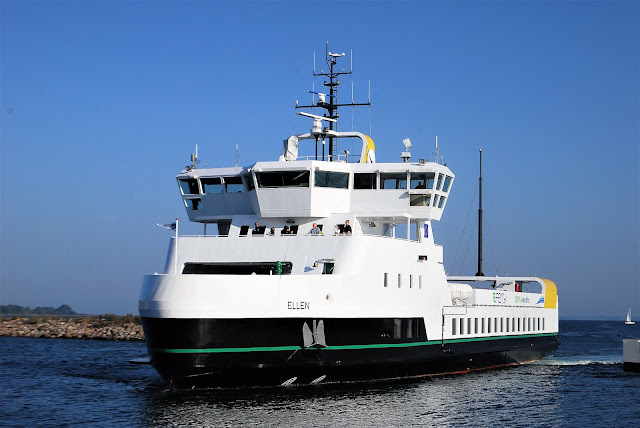 | ||
| The E- ferry Ellen has been operating between islands in Southern Denmark since
2019. Although it cost 40% more to build than conventional ferries it
saves 75% per year in operating costs. It also saves 2,000 tonnes of CO2
from entering the atmosphere and is clean and quiet. |
Problems and solutions
Shipping is responsible for almost 3% of global emissions which means around 940 million tons of carbon dioxide. However, the heavy bunker fuel used means that a single container ship also releases 5,000 tons of sulphur oxides (SOx) per year and sooty particulates which contribute to air pollution and are especially detrimental to human health. In 2008 shipping volumes totalled 900 million tonnes. By 2018 they had reached 3 billion tonnes which were carried by 60,000 ships, and that volume is set double on 2015 volumes by 2050.
Eighty percent of the world’s goods currently go by ship and can range from railway locomotives, to frozen food or bulk chemicals. Vessels also vary in size and can be cruise ships, ferries, tankers or container ships. As solutions go, no one size fits all. However, on a per tonne basis, shipping is still the one of the cheapest forms of transport and the costs per unit fall the bigger the ships are.
Battery Electric vessels (BEVs)
Smaller or short run vessels such as ferries, tugboats and supply vessels have benefited from advances in battery technology in automotive fields. Norway and other Scandinavian countries have been very much in the forefront of these developments but other countries are rapidly following suit. This is perhaps not surprising given Norway's rugged coastlines and seafaring traditions. After pioneering the first electric ferry in 2015, 60 were to be in service by 2021. It expects its entire fleet to be either fully electric or electric hybrid on longer routes by 2023.- In July 2020,
Norwegian shipping Company Fjords launched its second all electric ferry – the first
was in 2018. This is especially important because its eastern Fjords are UNESCO World Heritage sites.
- The UK’s first seagoing electric ferry the e-Voyager was launched in October 2020 and is
undergoing sea trials.
- The world’s largest electric ferry went into service in Norway in March 2021, the first of three being built in Turkey for Bastø Fosen.
- In April this year New Zealand took delivery of batteries for an all -electric ferry service for East by West Wellington Ferry company. The supplier Michigan company XALT Energy has already provided battery systems for two hybrid ferries for the UK’s P&O company between Calais and Dover which will begin operation by 2023.
- Also in April, Swiss company ABB supplied batteries for South Korea’s first electric ferry which will operate from the Port of Busan by 2023. South Korea expects that all 140 of its ferries will be running on clean energy by 2030.
- Dutch company Corvus Energy is supplying batteries for five electric ferries being built in the Netherlands, the first of which was to have begun operating in North Sea Canal routes from mid 2021
- Finnish Company Wärtsilä is developing electric ferries to be built in the Netherlands for Norway’s Boreal Sjø. It has already designed hybrid tugs for Norway’s Atlantic Offshore and Sweden’s Luleä Harbour. Wärtsilä also has the technology to retrofit existing ships with hybrid capacity.
- Another Norwegian Shipping company Norled, has commissioned three
plug -in hybrid electric ferries from Singapore’s Sembcorp.
- Battery electric ferries may soon be seen on waterways in Bangkok, New York and London. Norway of course has already had an autonomous one operating in Trondheim since 2018, the result of a Norwegian University of Science and Technology project which has since developed into a commercial operation.
- Finland's hybrid icebreakers are set to reduce its emissions by 40% over 1990 levels.
Cruise ships
Until recently cruise ships and larger vessels were considered too hard to decarbonise because of their massive size and the distances they travel. However, in November 2020, Italian shipbuilder Fincanteri, began incorporating ABB electric propulsion systems into five cruise ships being built by the company. Although the ships will still use diesel, the move is expected to reduce fuel consumption and hence emissions by 20%.
- Five days ago the world’s first LNG powered cruise ship, the Aida Nova, arrived in Hamburg. Although not electric and fossil fuel powered by Liquid Natural Gas (LNG), it still produces 40 -50% less emissions.
Bulk carriers and Container ships
- On Nov 22, 2021, The Yara Birkeland, the world's first fully autonomous zero emission electric container ship completed its maiden voyage to Oslo. It has the capacity to carry 120, 20 foot containers and will be used to transport fertiliser from a production facility in the south of Norway, for shipping from Brevik in the north, thus cutting out approximately 8,000 truck trips. In even more good news, although government enterprise ENOVA had allocated up to €133.5 million for its construction, it only cost €25 million, the same as a conventional vessel. While it is undergoing testing, the new ship will be controlled manually. However, equipped with radar, GPS, cameras and sensors, it can navigate and dock by itself.
These are just a few snippets from an ever growing list to show how fast this field is evolving. Read more about sea -going electrics here. More on bulk carriers and container ships next time. This thread is already way too long
Comments